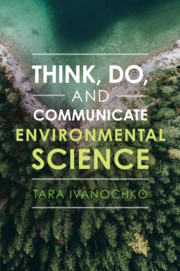Book contents
- Think, Do, and Communicate Environmental Science
- Think, Do, and Communicate Environmental Science
- Copyright page
- Contents
- Prologue
- Acknowledgements
- Introduction
- Part I Thinking Environmental Science
- Part II Doing Environmental Science
- Chapter 5
- Chapter 6
- Chapter 7
- Chapter 8
- Chapter 9
- Chapter 10
- Chapter 11
- Chapter 12
- 12 Developing Simple Environmental Models
- Part III Communicating Environmental Science
- Epilogue
- Appendix: Working in Excel
- Glossary
- Index
- References
12 - Developing Simple Environmental Models
from Chapter 12
Published online by Cambridge University Press: 23 April 2021
- Think, Do, and Communicate Environmental Science
- Think, Do, and Communicate Environmental Science
- Copyright page
- Contents
- Prologue
- Acknowledgements
- Introduction
- Part I Thinking Environmental Science
- Part II Doing Environmental Science
- Chapter 5
- Chapter 6
- Chapter 7
- Chapter 8
- Chapter 9
- Chapter 10
- Chapter 11
- Chapter 12
- 12 Developing Simple Environmental Models
- Part III Communicating Environmental Science
- Epilogue
- Appendix: Working in Excel
- Glossary
- Index
- References
Summary
Models are simplified representations of reality. We use models in many different ways, for many different purposes: physical models are used to study urban planning, vehicle impacts, new inventions, and molecular structures; rats are used as model organisms to test new pharmaceuticals for side effects; conceptual models are used to simplify and understand concepts, ideas, and relationships; mathematical models are used to understand, quantify, and predict the behaviour of the natural world. All models are intended to capture some key feature of reality (shape, behaviour, relationships, etc.); the specific focus of a model will depend on the purpose for which the model is intended to be used.
- Type
- Chapter
- Information
- Think, Do, and Communicate Environmental Science , pp. 171 - 196Publisher: Cambridge University PressPrint publication year: 2021

